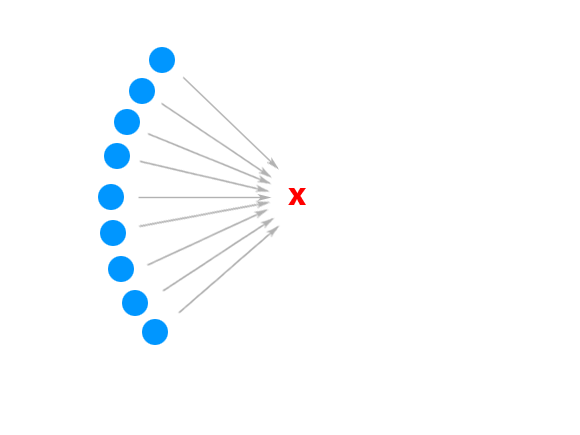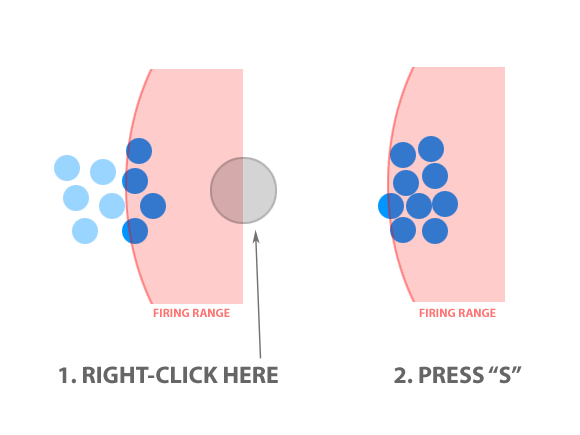Welcome back to another edition of Micro for Noobs where we I learn to win StarCraft 2 battles with zero actions per minute. In the last episode we were talking about some general battle dynamics and how units get more efficient in large quantities. Today we are going to go into specifics of ranged units. Ranged units are important in StarCraft 2 because it is a game where a majority of units is ranged. In fact, there are only 3 real melee units (Zerglings, Zalots and Ultralisks). So it makes sense to learn how to use the rest efficiently. And the key to ranged unit efficiency is the mythical Concave!
The idea of the concave is actually simple. In order to use your ranged units most efficiently, you want then to shoot all the time during the battle and as early as possible. The most efficient formation your units will take when they do that is to stand in a circle around the enemy force with the radius of the circle being their maximum firing range.

Good: All 9 units are able to fire at the enemy. They form a concave.
Conversely, what happens when the units are NOT efficient is when just a few units are in the front firing while a large force is in the back struggling to get in range. There is not really a fancy Gosu name for this so I will call this a “pile-up”. When you still remember the last post from this series you should be able to see why this is bad. A pile-up causes your huge army to fight as a series of small armies. And as we know, the bigger army is always much more efficient than the smaller army.

Not Good: Only 4 units are able to fire. 5 units are outside of firing range. This reduces our 9 unit army to practically just 4 units.
So the key to use your ranged unit wisely is to have a good, wide concave and to prevent any pile-ups from happening. Also, you may want to do anything you can do to disrupt the concave of your enemy and to cause pile-ups to them. So now comes the time where I will reveal the secret on how to pull this off: you look at the map and choose the spots where you engage the enemy wisely.
Generally, your units will tend to actually from a decent concave on their own if they only have enough room to expand. On the other hand, the easiest way to cause a pile-up at your enemy’s army is to engage them when they are in a narrow gap – a choke-point. Luckily the maps in StarCraft 2 are full of various narrow spots you can exploit to your advantage. You just need to remember to look beyond just the ramps. Especially later in the game, when the armies get big, even relatively sizable passages can make a huge difference for the efficiency of ranged units. And if this is not enough, you can still use force-fields and buildings to artificially narrow things down. In any case, the key is to look at the surrounding terrain with the concave in mind and to retreat from battles when you see yourself not having enough space.

Red are places where your units generally shouldn’t be standing when engaging the enemy.
But even if you have enough space, each army will eventually get so big that it will get in the way of itself. The first units that approach a battle will stop when they are able to fire and create an impenetrable wall for the units in the back. The units in the back may find their way to the front only after a longer struggle or only once the units in the front are dead. In this case we actually need to do some *GASP* real micro. You want to go… one step forward. The way to do that is to:
- select your army
- right-click on the ground in front of your army
- press S a split-second afterwards
That’s it. All your units will stop fring, walk one step forward, stop and start firing again. If things go well, the units in the back will now be in range so more units will be firing now. This additional damage will likely offset the wasted split-second of nor firing.

Do I have to do everything myself? How to get all units in firing range quickly.
So the concave is the key on how to use your ranged units in a battle efficiently.
It’s the reason why choke points such as ramps are strategically so important.
It’s the reason why wall-ins and smart building placement can be so effective.
It’s the whole point of abilities such as the Protoss force-field.
It’s the reason why flanking can be so devastating (double-concave all the way!)
In fact in our next episode we shall see that even the melee units have their own version of concave called “Surround” and how it is EVEN MORE important. Until then:
Game Designer’s Corner: It’s interesting to note that it would have been conceivable to come up with a path-finding routine that would not suffer from this problem. Units in the front could pay attention if they are holding other units back from firing and simply move aside. In fact, this is what happens outside of battle. This means that this is actually a deliberate game design feature. Abilities like force-field, to some extent Fungal Growth and the general design of multi-player maps seem to play into this. Star Craft 2 is consciously designed with this aspect being a core part of the gameplay. The takeaway is that not everything in a game needs to be intelligent and user-friendly. It’s absolutely possible to stop at some point and to declare a usability issue into a game mechanic. However this needs to be a conscious decision rather than accident in oder to take full advantage from it.





